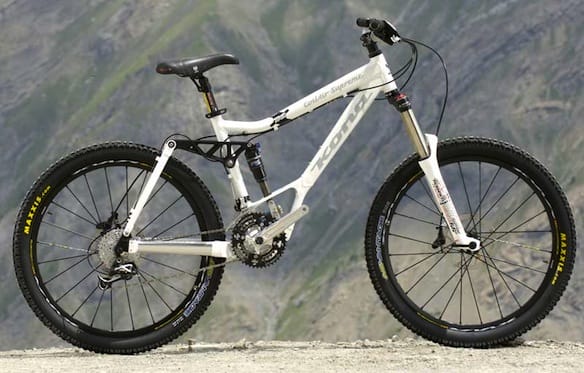
Image credit: Bike Magic.
Kona Bikes History and Profile
Palm trees, blue surf, and volcanoes to inspire the mountain biker – why shouldn’t Hawaii be the source of some great bikes? If you thought “Kona” – as in the Kona bicycle company – you’d be forgiven for assuming it was Hawaii-based. Turns out, Kona bikes emerge from the ruggedly beautiful Cascade range outside of Ferndale, Washington and Vancouver, British Columbia. There, in 1988, partners Jacob Heilbron, Dan Gerhard, and early MTB champion Joe Murray started Cascade Bikes, but a trademark kerfuffle forced a name change. Heilbron and Gerhard had an affinity for Hawaii, and Kona became the name.
Early models of Kona’s mountain bike line drew upon the Hawaiian theme with names like the Cinder Cone, Explosif, Hei Hei (Hawaiian for “race”), Hahannah (Hawaiian for “hot”), Fire Mountain, Hot, Lava Dome and Kilauea. In later years whimsical names like Stinky and Coiler were applied to some models.
Live Aloha – Kona’s Kulture
Many companies say they want to “share the love” of cycling and that their products are designed to encourage beginners and experts alike. But Kona demonstrates its commitment through bicycling advocacy, philanthropy, and partnerships with national parks. It’s all designed to grow cycling, provide social value, and have fun!
Advocacy/Philanthropy
Kona has been an active participant and sponsor of IMBA – the International Mountain Bicycling Association – since 1994. IMBA is the interest group that fights to preserve off-road cycling opportunities. Whatever your politics and views on trail access – and there are many – one can hardly find fault with a mountain bike company for associating with grassroots groups that enhance their customer base.
More recently, in 2006, Kona partnered with Bristol-Meyers Squibb and Bicycling Magazine to start BikeTown Africa. This program provided bikes to help health care workers reach people in need in rural Africa. The program took off, and by 2008 Kona’s customers and cyclists in general were so supportive that Kona pledge to provide 1,000 bikes in Arica.
Bikeparks
Kona is the official bicycle supplier to a dozen beautiful national and regional parks in the USA, Europe, and Scandanvia. With co-sponsorships from companies like SRAM, Wilderness Trail Bikes, RockShox, and others, the goal is to partner with natural resource agencies to provide an environmentally responsible but still epic cycling experience. Kona even maintains its own BikePark Environmental Guidelines handbook for users.
OK, The Hardware
It’s great to know the corporate culture at Kona is supportive of the joys that cycling can bring. And that it puts is money where its mouth through its philanthropy and affiliations with bike programs at parks. But how about the bikes?
Describing in detail all the offerings that Kona provides would be like listing all the beds and tables that IKEA carries. There are a lot! Just to give some context – Kona sells a total of 35 different kinds of mountain bikes from downhill racers to cross-country steeds to all-around off-road styles. Both 29ers and 26 inch wheel sizes, full suspension and hardtails. Six different road bikes are available, four cyclocross, 9 commuter bikes and 7 different kids styles. Few manufactures even provide full-blown descriptions of their kid’s bikes if they make them.
Here is just a smattering of what Kona has to offer:
Mountain
At $2800 the downhill racing Entourage model was voted “overall favorite” in Bike Magazine’s “Bible of Bike Tests.” It features an aluminum frameset, Avid brakes, and a geometry that maximizes speed. The Entourage is several hundred dollars less than the top-end Operator, but the bones are the same.
The Hei Hei is Kona’s main offering in its cross-country race line. For the base model at $1900 you get a 29er with Kona’s unique “Scandium” frame material – aluminum reinforced with a rare earth element that adds strength without much weight. The Hei Hei DL and Supreme models add superior components and will set you back as much as $5500.
Fixed gear mountain bikes include the Unit at about $1000, using a cromoly frame and disc brakes. Kona offers the most choices in its “MTB Trail – 29er Hardtail” category with nine different models built around 2 distinct framesets. There are plenty of price points and incremental steps in quality to please anyone searching for a new off-road mount.
Road / ‘Cross
Fifteen years after getting started, Kona continues to break new ground – at least for itself. 2013 marks the first year that Kona is offering a carbon frame on endurance road models. The Red Zone ($5500 and featuring SRAM Red components) and Zone Two ($3800 with Ultegra specs) are designed to be comfortable over long rides yet still be quick and efficient. Kona offers other choices in its road line like the Zing Supreme ($2200 for carbon frame and 105 components) and the Honky Tonk (about $1000 for a cromoly frame and FSA specs) Kona’s four ‘cross models range from the Major Jake ($3500 with carbon frame and Ultegra components) to the entry level Jake ($1150 for a aluminum frame and Shimano Tiagra features). Not the most heavily populated of Kona’s lines, but given its more than a decade in the cyclocross arena, one shouldn’t confuse quantity for quality.
Kids
Kona clearly doesn’t shortchange the shorter customers. It offers a range of mountain bikes starting at around $380 (the Makena with bare-bones features but still offering 7 speeds and a front shock) to a full-suspension, disc-brake equipped, 24” wheeled Stinky ($1700). Kona even offers a kids’ sized road/cross frame – the Jake 24 at $850 – that features an aluminum frame, traditional 2×9 gearing, and V-brakes with adjustable levers to modify the reach for small hands.
Kona may not be the oldest or most ubiquitous shop around. But its dedication to quality, holistic view of the world of cycling – and the people in it – and commitment to designing high-performing yet versatile bikes has made it a company to admire.



